Korean War Veterans Memorial
The Korean War Veterans Memorial is located in Washington, D.C.'s West Potomac Park, southeast of the Lincoln Memorial and just south of the Reflecting Pool on the National Mall. It memorializes those who served in the Korean War.
Korean War Veterans Memorial | |
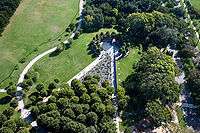 Aerial view of the Korean War Veterans Memorial | |
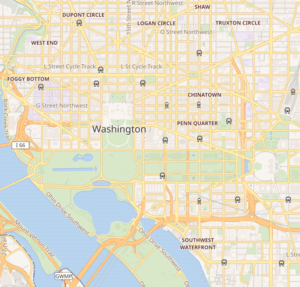   | |
| Location | SE of Lincoln Memorial, off Independence Ave., Washington, D.C. |
|---|---|
| Coordinates | 38°53′16″N 77°2′50″W |
| Area | 2.20 acres (0.89 ha) |
| Visitation | 3,214,467 (2005) |
| Website | Korean War Veterans Memorial |
| NRHP reference No. | 01000273[1] |
| Added to NRHP | July 27, 1995 |
History
The Korean War Veterans Memorial was confirmed by the U.S. Congress (Public Law 99-572) on April 20, 1986,[2] with design and construction managed by the Korean War Veterans Memorial Advisory Board and the American Battle Monuments Commission.
The initial design competition was won in 1986 by a team of four architects from The Pennsylvania State University, but this team withdrew as it became clear that changes would be needed to satisfy the advisory board and reviewing agencies such as the Commission of Fine Arts. A federal court case was filed and lost over the design changes. The eventual design was by Cooper-Lecky Architects who oversaw collaboration between several designers.[3]
President George H. W. Bush conducted the groundbreaking for the Memorial on June 14, 1992 , Flag Day, and thus construction was started. The companies and organizations involved in the construction are listed on the memorial as: the Faith Construction Company, the Emma Kollie Company, the Cold Spring Granite Company, the Tallix Art Foundry and the Baltimore District of the US Army Corps of Engineers. The memorial was dedicated on July 27, 1995, the 42nd anniversary of the armistice that ended the war, by President Bill Clinton and Kim Young Sam, the South Korean president, to the men and women who served during the conflict. Management of the memorial was turned over to the National Park Service, under its National Mall and Memorial Parks group. As with all National Park Service historic areas, the memorial was administratively listed on the National Register of Historic Places on the day of its dedication.
Design and construction
The Mural Wall
The main memorial is in the form of a triangle intersecting a circle. Walls: 164 feet (50 m) long, 8 inches (200 mm) thick; more than 100 tons of highly polished "Academy Black" granite from California: more than 2,500 photographic, archival images representing the land, sea, and air troops who supported those who fought in the war are sandblasted onto the wall. The Mural was created by Louis Nelson, with photographic images sandblasted into it depicting soldiers, equipment and people involved in the war. When reflected on the wall, there appear to be 38 soldiers, 38 months, and it is also representing the 38 parallel that separated the North and South Korea.[4]
19 stainless steel statues
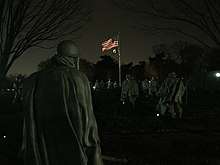
Within the walled triangle are 19 stainless steel statues designed by Frank Gaylord,[5] each larger than life-size, between 7 feet 3 inches (2.21 m) and 7 feet 6 inches (2.29 m) tall; each weighs nearly 1,000 pounds (500 kg). The figures represent a platoon on patrol, drawn from branches of the armed forces; fourteen of the figures are from the U.S. Army, three are from the Marine Corps, one is a Navy Corpsman, and one is an Air Force Forward Air Observer. They are dressed in full combat gear, dispersed among strips of granite and juniper bushes which represent the rugged terrain of Korea.[6]
United Nations Wall
To the north of the statues and path is the United Nations Wall, a low wall listing the 22 members of the United Nations that contributed troops or medical support to the Korean War effort.
Pool of Remembrance
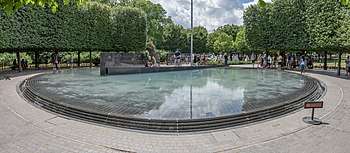
The circle contains the Pool of Remembrance, a shallow pool 30 feet (9 m) in diameter lined with black granite and surrounded by a grove of linden trees with benches. The trees are shaped to create a barrel effect, which allows the sun to reflect on the pool.[7] Inscriptions list the numbers killed, wounded, missing in action, and held as prisoners of war, and a nearby plaque is inscribed: "Our nation honors her sons and daughters who answered the call to defend a country they never knew and a people they never met." Additionally, right next to the numbers of American soldiers are those of the United Nations troops in the same categories. In the south side of the memorial, there are three bushes of the Rose of Sharon hibiscus plant, South Korea's national flower.
A further granite wall bears the simple message, inlaid in silver: "Freedom Is Not Free."
Korean War Veterans Memorial Foundation's Maintenance Fund
On October 12, 2015, Samsung Electronics donated $1 million to the Korean War Memorial Foundation. The memorial used the donation for maintenance. According to William Weber, the chairman of the memorial foundation, "Most of the grouting need to be treated twice a year. And there isn't enough for all of that upkeep." In addition, on October 16, Samsung helped clean the memorial ground as part of the company's national day of service.[8]
Troop statistics
Engraved on granite blocks near the water pool at the east end of the monument are the.
United States postage stamp court case
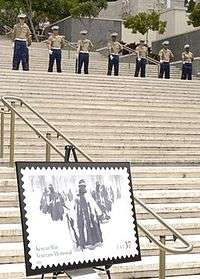
On February 25, 2010, the United States Court of Appeals for the Federal Circuit ruled on appeal that the memorial-sculptor Frank Gaylord was entitled to compensation for a 37-cent postage stamp—which used an image of the sculpture—because he had not signed away his intellectual-property rights to the sculpture when it was erected. The appeals court rejected arguments that the photo was transformative.[16]
In 2002, amateur-photographer and retired Marine John Alli was paid $1,500 for the use of one of his photographs of the memorial on a snowy day for the stamp,[17] which sold more than $17 million worth of stamps. In 2006, sculptor Frank Gaylord enlisted Fish & Richardson to make a claim that the Postal Service had violated his intellectual-property rights to the sculpture and therefore he should have been compensated. The Postal Service argued that Gaylord was not the sole sculptor (saying he had received advice from federal sources, who recommended that the uniforms appear more in the wind) and also that the sculpture was actually architecture. Gaylord won all of his arguments in the lower court except for one—the court ruled the photo was fair use and thus he was not entitled to compensation.[18] Gaylord challenged the fair-use ruling and won the case on appeal.[16]
Gaylord had sought compensation of 10 percent of the sales. Gaylord's original commission was $775,000. [19] On April 22, 2011, the US Court of Federal Claims awarded Gaylord $5,000.[20] On appeal, the US Court of Appeals for the Federal Circuit vacated the order and remanded the case back to the US Court of Federal Claims. On September 20, 2013, the US Court of Federal Claims awarded Gaylord $684,844.94 in damages, including interest.[21]
See also
References
- "National Register Information System". National Register of Historic Places. National Park Service. March 13, 2009.
- "U.S. Corps of Engineers, Baltimore District, Korean War Memorial". Nab.usace.army.mil. Archived from the original on 2012-12-15. Retrieved 2012-12-17.
- A March to Remember Archived 2016-03-04 at the Wayback Machine, Benjamin Forgey, The Washington Post , 22 July 1995 (hosted by www.louisnelson.com)
- "Korean War Memorial". American Battle Monuments Commission. Korean War Memorial. Retrieved 28 October 2015.
- "Korean War Veterans Memorial, Washington, D.C". Nab.usace.army.mil. Archived from the original on 2012-12-15. Retrieved 2012-12-17.
- "U.S. Army Corps of Engineers – Baltimore District – Projects – Korean War Veterans Memorial, Washington, D.C". Nab.usace.army.mil. Archived from the original on 2012-12-15. Retrieved 2012-12-17.
- "Korean War Veterans Memorial". American Battle Monuments Commission. Archived from the original on 2013-07-03. Retrieved 2013-06-21.
- Shane, Leo (12 October 2015). "Korean War Veterans Memorial Gets $1M Donation from Samsung". Military Times. Retrieved 28 October 2015.
- The ABRAM (American Battlefield Monuments Commission) MIA. The more commonly used number–36,516–only includes the deaths that occurred as a direct result of the Korean War.
- "Defense Casualty Analysis System". Archived from the original on 2013-02-22. Retrieved 2019-09-11.
- "Wall of Remembrance". Retrieved Sep 11, 2019.
- "How Many Americans Died In Korea?". www.cbsnews.com. Retrieved Sep 11, 2019.
- The number of actual deaths of ROK Army in the war is 137,899 according to South Korean Ministry of National Defense
- 664 is the current number defined as living missing personnel of the end of the war.
- "As of June 2015 the estimated number of unaccounted for/body unidentified service people is 7,850" (PDF). Archived from the original (PDF) on December 27, 2018. Retrieved Sep 11, 2019.
- "An 85-Year-Old Sculptor vs. The Government – amlawdaily – February 25, 2010". Amlawdaily.typepad.com. Retrieved 2012-12-17.
- "Archived copy". Archived from the original on 2011-07-11. Retrieved 2010-03-01.CS1 maint: archived copy as title (link)
- "Postage Stamp Depicting Portion of Korean War Veterans Memorial Not Fair Use of Sculpture" Archived 2012-07-19 at Archive.today, Hendricks & Lewis, Stacia Lay, February 26, 2010
- Postal Service must pay sculptor – Bloomberg News (via Chicago Sun-Times) – February 27, 2010
- Mike Doyle (April 25, 2011). "Korean War memorial sculptor wins and loses at the same time". McClatchy.
- http://www.uscfc.uscourts.gov/sites/default/files/opinions/WHEELER.GAYLORD092013.pdf
Bibliography
- Korean War Vererans Memorial, National Park Service leaflet, GPO:2204—304-337/00178
- The National Parks: Index 2001–2003. Washington: U.S. Department of the Interior.
External links
| Wikimedia Commons has media related to Korean War Veterans Memorial. |
- Official NPS website: Korean War Veterans Memorial
- Trust for the National Mall: Korean War Memorial
- 15 photos at "Sites of Memory"
- Evocative photo of the Memorial in weather worthy of waterproof clothing
- View of the memorial's statues, with the Lincoln Memorial in the background
- Smithsonian Database on the Memorial
- War Memorial of Korea
- "Gaylord vs. U.S.", United States Court of Federal Claims, April 22, 2011
- Korean War Veterans Memorial Photo Collection